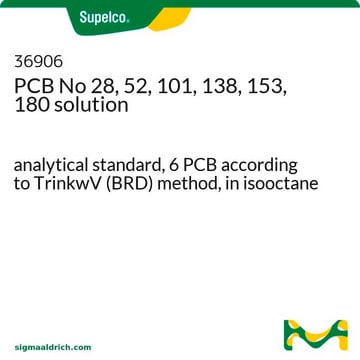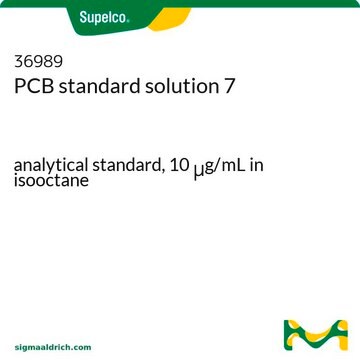35596
PCB No 3
analytical standard
Synonym(s):
4-Chlorobiphenyl, 4-PCB
Sign Into View Organizational & Contract Pricing
All Photos(1)
About This Item
Empirical Formula (Hill Notation):
C12H9Cl
CAS Number:
Molecular Weight:
188.65
Beilstein:
774966
Ballschmiter Number:
3
EC Number:
MDL number:
UNSPSC Code:
41116107
PubChem Substance ID:
NACRES:
NA.24
Recommended Products
grade
analytical standard
shelf life
limited shelf life, expiry date on the label
technique(s)
HPLC: suitable
gas chromatography (GC): suitable
application(s)
environmental
format
neat
SMILES string
Clc1ccc(cc1)-c2ccccc2
InChI
1S/C12H9Cl/c13-12-8-6-11(7-9-12)10-4-2-1-3-5-10/h1-9H
InChI key
FPWNLURCHDRMHC-UHFFFAOYSA-N
Looking for similar products? Visit Product Comparison Guide
Related Categories
General description
Polychlorinated biphenyls (PCBs) belong to the class of highly toxic pollutants commonly found in various environmental matrices and food products. They find a variety of applications as flame retardants, plasticizers, dielectric and heat transfer fluids, etc.
Application
PCB No 3 may be used as an analytical reference standard for the quantification of the analyte in aqueous solution in the presence of dissolved organic carbon using high-performance liquid chromatography technique.
Refer to the product′s Certificate of Analysis for more information on a suitable instrument technique. Contact Technical Service for further support.
Recommended products
Find a digital Reference Material for this product available on our online platform ChemisTwin® for NMR. You can use this digital equivalent on ChemisTwin® for your sample identity confirmation and compound quantification (with digital external standard). An NMR spectrum of this substance can be viewed and an online comparison against your sample can be performed with a few mouseclicks. Learn more here and start your free trial.
Signal Word
Warning
Hazard Statements
Precautionary Statements
Hazard Classifications
Aquatic Acute 1 - Aquatic Chronic 1 - STOT RE 2
Storage Class Code
11 - Combustible Solids
WGK
WGK 3
Flash Point(F)
Not applicable
Flash Point(C)
Not applicable
Personal Protective Equipment
dust mask type N95 (US), Eyeshields, Gloves
Choose from one of the most recent versions:
Already Own This Product?
Find documentation for the products that you have recently purchased in the Document Library.
Customers Also Viewed
Markus Alexander Zettner et al.
Toxicological sciences : an official journal of the Society of Toxicology, 100(1), 88-98 (2007-08-10)
4-Monochlorobiphenyl (PCB3) is a component of commercial polychlorinated biphenyl (PCB) products and is an airborne environmental pollutant. Our recent study with transgenic Fischer 344 rats revealed the mutagenic potential of PCB3 in the livers of male rats. PCB3 is converted
Guangshu Zhai et al.
Environmental science & technology, 47(1), 557-562 (2012-12-12)
4-Monochlorobiphenyl (PCB3) has been proven to be transformed into hydroxylated metabolites of PCB3 (OH-PCB3s) in whole poplar plants in our previous work. However, hydroxylated metabolites of PCBs, including OH-PCB3s, as the substrates of sulfotransferases have not been studied in many
Parvaneh Espandiari et al.
Toxicological sciences : an official journal of the Society of Toxicology, 79(1), 41-46 (2004-02-21)
We recently reported that several mono- to tetrachlorinated biphenyls have initiating activity in the livers of Fischer 344 rats. In the present study, we investigated the metabolic activation of one of those compounds, 4-chlorobiphenyl (PCB 3). Monohydroxy (400 micromol/kg), dihydroxy
Guangshu Zhai et al.
Environmental science & technology, 44(10), 3901-3907 (2010-04-21)
4-Monochlorobiphenyl (CB3), mainly an airborne pollutant, undergoes rapid biotransformation to produce hydroxylated metabolites (OH-CB3s). However, up to now, hydroxylation of CB3 has not been studied in living organisms. In order to explore the formation of hydroxylated metabolites of CB3 in
Anna Ptak et al.
Reproductive toxicology (Elmsford, N.Y.), 20(1), 57-64 (2005-04-06)
Theca interna and granulosa cells from small, medium and large preovulatory porcine follicles were cultured as a monolayer to compare the effects of 4-chlorobiphenyl (PCB3) and its metabolites on estradiol secretion. Cells were treated with PCB3 or its mono- and
Our team of scientists has experience in all areas of research including Life Science, Material Science, Chemical Synthesis, Chromatography, Analytical and many others.
Contact Technical Service











